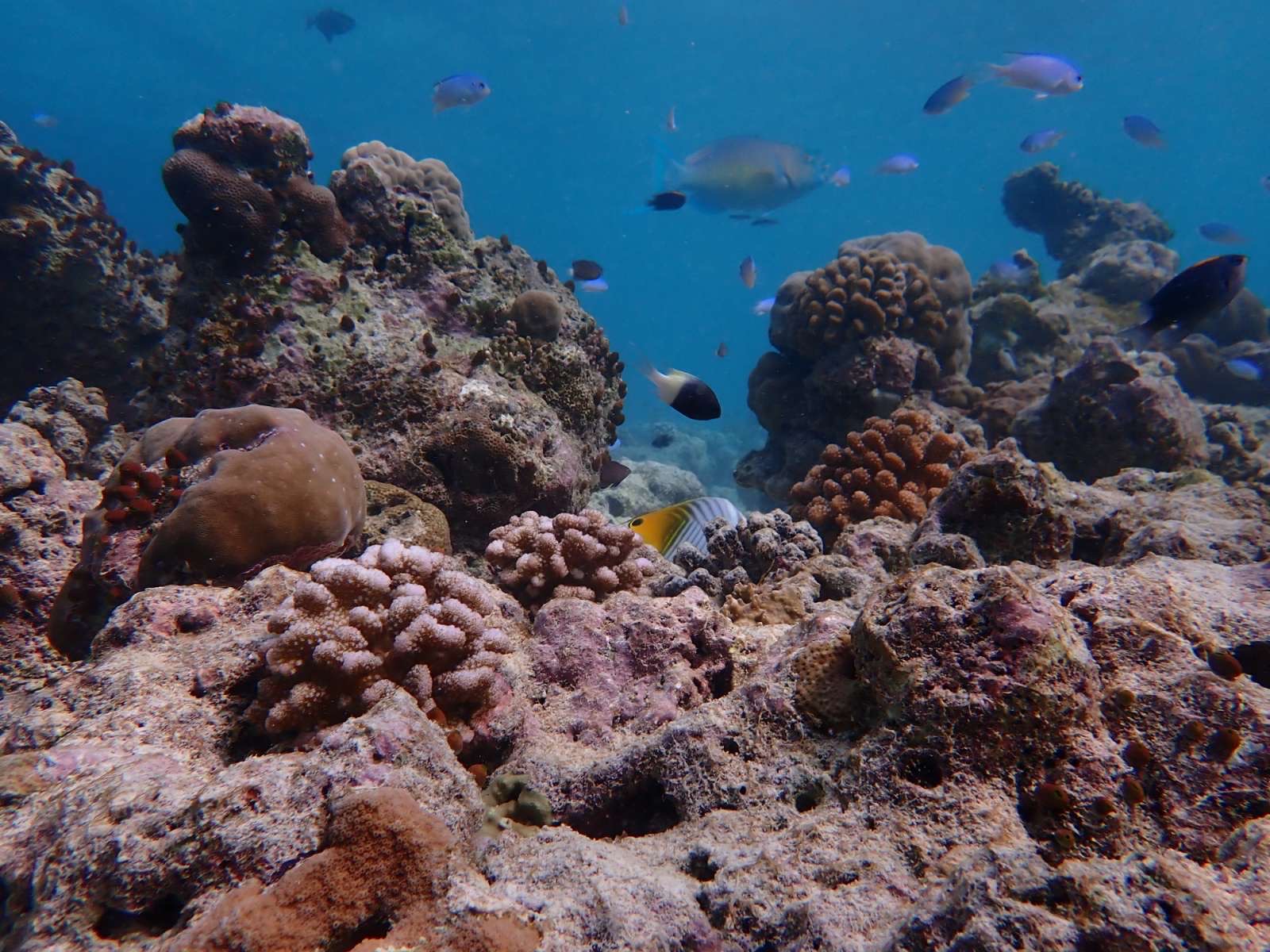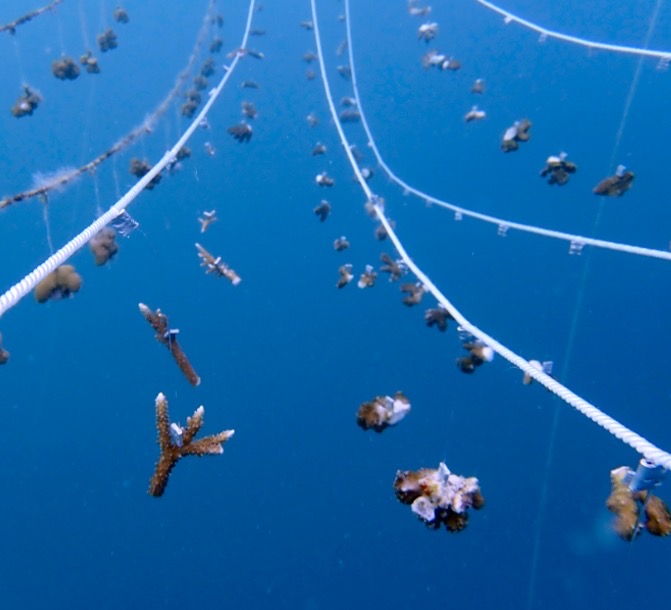News
The Maldivian Coral Carers – An insight into Active Coral Restoration Techniques

A guest post for Scubaverse by Chloe Brown.
Chloe is a graduate from the University of Southampton where she studied for a BSc Oceanography. She started her diving career whilst studying, which led to her current job working for Velaa Private Island in the Maldives. Chloe works together with the resident marine biologist and coral biologist restoring the house reef while conducting new innovative research to improve restoration techniques.
The reality of climate change beneath the waves is more detrimental than the majority are aware. Among all the reefs found across the globe, 50% have been destroyed in recent years in response to anthropogenic stressors. Unfortunately, these beautiful habitats are tucked away and the effects easily go unnoticed, deteriorating further. This is not the case for the diving community who are unfortunately witnessing this rapid decline in corals and marine life. Therefore, multiple restoration efforts worldwide have jumped in to attempt to restore one of the world’s greatest wonders, before it is too late.

Restoration Techniques
Coral restoration initiatives aim to restore the overall health, abundance, and biodiversity improving the reef’s tolerance to external stressors. The process behind this is to utilize the existing corals to clone them and repopulate the reef. The fact these corals are still surviving on the reefs, despite the natural disturbances, indicates strong resilient characteristics that are very valuable to restoration projects. These corals act as “donor colonies” as small fragments are broken off to be grown in nurseries and later transplanted back onto the reef.

Here at Velaa Private Island, we use the floating mid-water nursery set up. These consist of 1,500 corals and we currently have two of these nurseries in place. Our nurseries mainly hold Pocillopora spp. as it is extremely tolerable with a high prevalence rate. We attach the small fragments taken from the donor colonies with monofilament and crimps to the nurseries, where they grow for a year. This nursery is situated at a depth of 8m (anchored at 30m) and located away from the reef. Growing away from the reef reduces predation, moderates competition, and allows depth alterations during warmer months to mitigate bleaching effects. Other key nursery designs are being trialed by other restoration efforts worldwide. These include coral trees, net nurseries, and ex-situ nurseries in laboratories, where the conditions can be monitored and controlled 24 hours a day.

During transplantation, we use marine cement to attach the corals to rocks and other hard surfaces found along the reef. Over time these corals will propagate outwards via asexual reproduction growing over the adhesives securing themselves on to the reef.We have successfully transplanted over 4,500 corals with a 70% survival rate. This has had a great effect on increasing the abundance and diversity of marine life present on the reef.
We have additionally conducted further research into effective ways to restore species diversity, specifically looking at massive species. It was found that massive coral species survive better when the fragments are transplanted directly onto the reef, skipping the nursery phase entirely. The ideal fragment size should be 1-2cm and attached to the substrate 1cm away from its clones, to allow fusion with growth. It was Dr. Vaughn who discovered that massive coral species grow quicker when they are cut into smaller fragments. He also discovered tissue fusion between clones however, his finding was taken from ex-situ experiments. It’s fantastic to see similar results in-situ with all the natural disturbances prevailing. The overall aim of restoration is to rehabilitate the reefs encouraging natural growth and self-sufficiency. We have certainly seen this as there was higher recruitment (coral larvae settlement) number in the transplant sites compared to the untouched degraded sites. Self-generation has been evident.

This is an insight into a few techniques used by restoration projects. Without reef restoration, it is predicted that a complete loss of coral reefs will be seen in the next 30 years, taking away, the home to 25% of all marine life. This signifies the importance of restoration and future conservation measures. To ensure the sustainability of restoration efforts education and awareness need to be conducted. Awareness needs to be ubiquitous as it is not just those living along the coasts who have an impact on the oceans, it’s everyone. People need to be taught about the reality of the ocean to induce a permanent change; otherwise coral reefs will lose the fight against mankind taking the marine life with it.
If you are interested in the work we are doing or just want to see some awesome underwater shots of marine life check out our Instagram page @velaacoralproject. We will be delighted to have you.
Gear News
Introducing the TR-80, IR-50 and CS-30 Regulators from DYNAMICNORD

Whether you are a beginner or a professional diver – with the three new main regulators from DYNAMICNORD, everyone will find their favourite regulator. They all look super stylish.
Excellent performance with the TR-80
Quality and performance are the be-all and end-all for regulators. It is not for nothing that the TR stands for Tec Reg. The innovative design of the TR-80 guarantees absolute reliability – even in ice-cold waters.

Perfect breathing effort at 0.8 J/l / certified for diving in waters below 10 degrees / structural design made of solid brass for best cold protection / membrane-compensated design with dry seal of the first stage / reduced exhalation effort thanks to optimized exhalation membrane and bubble deflector / adjustable Venturi (dive/predive) and adjustment knob for individual inhalation comfort / innovative design of the front cover prevents free-flow in strong currents or when diving with scooters / design made of sandblasted brass, matt chrome finish / 2 HP and 4 LP outlets / mouthpiece made of high-quality, anti-allergic silicone for maximum comfort.


Amazing underwater adventures with the IR-50
The IR-50 is the top regulator for advanced and experienced divers. Natural breathing is the essence of this regulator.

Ideal breathing effort at 0.8 J/l /certified for diving in waters below 10 degrees / compensated membrane / adjustable venturi (dive/predive) and adjustment knob for individual inhalation comfort/ outlet valve and deflector for minimum exhalation effort and reduction of bubbles on the face / design made of sandblasted brass, matt chrome finish / 2 HP and 4 NP outlets / mouthpiece made of high-quality, anti-allergic silicone for maximum comfort.


The Workhorse – our CS-30
For diving centres and diving beginners – the workhorse stands for strong construction, reliability and robustness. Perfect for your training.

Optimal breathing effort at 0.8 J/l /recommended for diving in waters above 10 degrees / non-compensated piston / adjustable venturi (dive/predive) / outlet valve and deflector for minimum exhalation effort and reduction of bubbles on the face / design made of sandblasted brass, matt chrome finish / 1 HP and 3 NP outlets / mouthpiece made of high-quality, anti-allergic silicone for maximum comfort.


Octopus OP-30
The OP-30 is the ideal addition to all DYNAMICNORD regulators. It is identical in construction to the CS-30.

The TR-80, IR-50, CS-30 (DIN & INT) regulators and the Octopus OP-30 are available from DYNAMICNORD dealers and in the online store.
DYNAMICNORD – Your Outdoor Companion.
Marine Life & Conservation
Paul Watson Released as Denmark Blocks Japan’s Extradition Bid

Renowned anti-whaling activist Paul Watson has been released from custody in Greenland after spending five months in detention. Denmark’s Justice Ministry rejected Japan’s request for his extradition, citing insufficient guarantees that his time already served in custody would be credited against any potential sentence.
The 74-year-old Canadian-American was arrested on July 21 in Nuuk, Greenland’s capital, when his ship docked to refuel. His arrest was based on a 2012 Japanese warrant related to a 2010 encounter in Antarctic waters. Japan alleged Watson obstructed operations and caused damage to a whaling research ship during efforts to disrupt illegal whaling. Watson has consistently denied these claims, maintaining his commitment to marine conservation.
Denmark, which oversees extradition matters for Greenland, concluded that while the legal conditions for extradition were met, the lack of assurances from Japan regarding time-served credit made extradition untenable.
In a video shared by his foundation, Watson expressed gratitude and relief, saying, “After five months, it’s good to be out… and good to know they’re not sending me to Japan.” He added that the most difficult part of his time in custody was being separated from his two young sons.
Watson is a pioneering figure in marine conservation, known for founding the Captain Paul Watson Foundation in 2022 after decades of activism with the Sea Shepherd Conservation Society. His bold efforts to defend marine life have earned him widespread support, including from celebrities and conservationists. His work has also been featured in the acclaimed reality TV series Whale Wars.
Watson’s lawyer, Jonas Christoffersen, praised the decision, stating, “We are happy and relieved that Paul Watson is now free.” He added that Watson is eager to reunite with his family and continue his vital work.
The arrest occurred while Watson’s vessel, the M/Y John Paul DeJoria, was en route to the North Pacific with a team of 26 volunteers to intercept a Japanese whaling ship. His foundation described the arrest as politically motivated and emphasized that Watson’s actions were focused on ending illegal whaling practices.
Japan resumed commercial whaling in 2019 after leaving the International Whaling Commission, asserting that whale meat is a cultural tradition. Conservationists, however, continue to challenge these practices, highlighting their impact on marine ecosystems.
Despite the challenges, Watson remains steadfast in his mission to protect marine life and bring attention to whaling practices. His dedication to ocean conservation has made him a globally respected advocate for the environment.
-

 News2 months ago
News2 months agoIconic SS United States to become the World’s Largest Artificial Reef
-

 News3 months ago
News3 months agoBook Review – 52 Assignments: Underwater Photography
-

 Gear News3 months ago
Gear News3 months agoDYNAMICNORD – New German diving brand enters the British market
-

 News3 months ago
News3 months agoExploring Cenote El Pit: A Diver’s Dream
-

 Gear News3 months ago
Gear News3 months agoTry BARE drysuits (and maybe even win one!) this Friday with Sea & Sea at North West Dive Fest
-

 Marine Life & Conservation3 months ago
Marine Life & Conservation3 months agoBook Review: Coral Triangle Cameos
-

 Blogs2 months ago
Blogs2 months agoDive the Egyptian Red Sea this Autumn with Regaldive
-

 News3 months ago
News3 months ago2024 Ocean Art Underwater Photo Competition Announced















